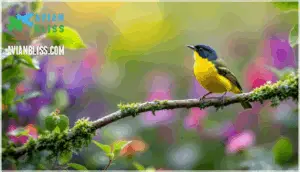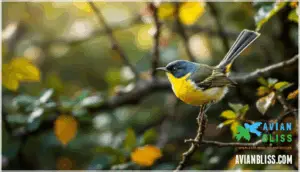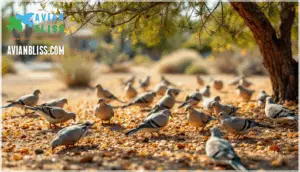This site is supported by our readers. We may earn a commission, at no cost to you, if you purchase through links.

Despite a global population of 81 million, these warblers have lost 60% of their numbers over the past fifty years, slipping away while most birders focus on flashier species.
Understanding what makes this black-capped dynamo tick—from its acrobatic foraging style to its genetic split into two ancient lineages—reveals why protecting scrubby wetlands and streamside thickets matters more than you’d think.
Table Of Contents
- Key Takeaways
- Habitat and Range of The Wilson’s Warbler
- Physical Characteristics and Identification
- Behavior and Diet
- Conservation Status and Threats
- Interesting Facts About The Wilson’s Warbler
- Frequently Asked Questions (FAQs)
- Where do Wilson warblers live?
- What are some interesting facts about Wilson’s warbler?
- What do Wilson’s warbler eat?
- What is the difference between yellow and Wilson’s warbler?
- What is the Wilsons Warblers call like?
- How long does the Wilsons Warbler live?
- Do multiple broods occur in a single breeding season?
- How does the Wilsons Warbler build its nest?
- How has climate change affected the Wilsons Warbler?
- What predators hunt Wilsons Warblers most frequently?
- Conclusion
Key Takeaways
- Wilson’s Warbler has lost 60% of its population over fifty years despite 81 million birds globally, earning a "Common Bird in Steep Decline" label—making protection of riparian thickets and streamside wetlands surprisingly critical for ecosystem health.
- Genetic studies reveal two populations split 2.3 million years ago into potential cryptic species, with six genetically distinct groups showing migration routes locked by ancient DNA that can’t adapt quickly to climate shifts.
- Every 1°C temperature increase causes a 1.5% annual population drop, especially at higher elevations, while their genetically fixed migration patterns prevent rapid adaptation to habitat changes.
- These three-quarter-weight warblers migrate thousands of kilometers between Alaska and Central America using leap-frog patterns where southern breeders head north before Arctic populations, demonstrating extraordinary navigation despite their size.
Habitat and Range of The Wilson’s Warbler
Wilson’s Warbler is a bird that truly lives up to the wanderer’s spirit, spanning an impressive range from the northern edges of Alaska down to the tropical warmth of Central America. Where you’ll find this little yellow dynamo depends entirely on the season and what part of its epic journey it’s on.
Let’s break down the breeding grounds, winter retreats, and the extraordinary migration routes that connect them.
Breeding Habitat and Range
When nesting season arrives, Wilson’s Warblers abandon their wandering ways and head for the continent’s northern frontiers—places where dense, low-growing thickets meet cold, clear water. You’ll find their breeding grounds stretching coast-to-coast across Canada and Alaska, with strongholds in the northeastern U.S., where these birds claim territories in:
- Riparian willow thickets along mountain streams
- Shrubby bog edges near boreal forests
- Second-growth clearings at timberline
- Dense alder tangles in wet meadows
- Overgrown streamside vegetation below 10 feet
These nesting sites provide perfect cover and abundant insects for raising young.
Wintering Habitat and Range
Once autumn chill sets in, these feisty yellow sprites trade Canada’s frosted willows for the sun-drenched lowlands of Mexico and Central America, where warm air and year-round insects make survival a whole lot easier. You’ll spot them across a remarkably broad wintering habitat, from southern California’s scrubby canyons to the humid forests of Panama, thriving in:
- Overgrown clearings and forest edges
- Dense riparian thickets along tropical streams
- Coffee plantations with shade canopy
- Second-growth scrublands rich with arthropods
Their adaptable overwintering strategies and broad habitat preferences across these migration range maps explain why Wilson’s Warbler range and distribution remain stable despite forest clearing—these birds don’t need untouched wilderness to make it through winter.
Migration Patterns
That’s how they get from breeding grounds to winter refuges, but the journey itself reveals something wilder. These nocturnal migrants fly thousands of kilometers each year, traveling overland at night and stopping by day to refuel at key stopover sites across southwestern British Columbia and the Rockies. Watch for them from March to May heading north, then again August through October as they reverse course.
Western populations leap-frog past southern breeders in a staggered dance shaped by fuel deposition rates, weather, and competition at rest stops along their migration routes. Understanding bird migration trends is vital for conservation efforts.
Physical Characteristics and Identification
Spotting a Wilson’s Warbler in the field is easier when you know what to look for. These tiny sprites have a few signature traits that set them apart from other warblers, though subtle variations exist across their range.
Let’s break down the key features that’ll help you confirm your identification.
Appearance and Size
If you’ve ever tried to spot a bird that seems to vanish the moment you blink, you’ve probably met the Wilson’s Warbler—a pint-sized dynamo that packs more personality per ounce than just about any songbird in North America. Here’s what sets this feathered rebel apart:
- Body proportions: At 4.5-5 inches, it’s sparrow-sized with a distinctly round head
- Feather color: Males sport lemon-yellow plumage head-to-tail
- Head markings: That jet-black cap on males? Unmistakable
- Plumage patterns: Females wear olive-green back feathers, sometimes with scattered black crown feathers
- Beak shape: Small, fine-tipped—perfect for nabbing insects mid-flight
This bright yellow body and olive-green back make identification straightforward once you’ve locked eyes with one.
Distinguishing Features
When you’re tracking warblers through tangled brush, the Wilson’s stands out not just for that signature black cap—it’s the tail that gives it away every time. Watch for that constant flicking motion as it darts through low foliage. Males wear that diagnostic black crown like a beret, while females show olive head markings—sometimes just a hint of dark feathers.
The beak shape is delicate and pointed, built for precision insect-snatching. You won’t find wing bars here; their plumage patterns are refreshingly simple.
Key warbler identification markers:
- Long tail in constant motion—flips upward while foraging
- No white patches in tail or wings (unlike most warblers)
- Round head profile with beady dark eyes that miss nothing
Subspecies Variations
Three formally recognized subspecies reveal striking differences shaped by geographic isolation. The coastal chryseola displays an orange-tinged crown—brighter plumage than its relatives. Meanwhile, pileolata roams western mountains, and pusilla claims eastern territories.
Phylogenetic analysis uncovers even deeper complexity: six genetically distinct populations separated by roughly 2.3 million years of divergence. These morphological traits and genetic diversity patterns prove essential for Wilson’s Warbler identification and understanding warbler species evolution.
Genetic studies on bird migration now track these variations, revealing which populations face steepest declines.
Behavior and Diet
Wilson’s Warbler doesn’t just sit still—it’s a bundle of kinetic energy, constantly on the move through low vegetation with quick flicks of its tail. You’ll notice it employs a toolkit of hunting strategies to snag insects, and its breeding conduct reveals some surprising twists in warbler social dynamics.
Let’s break down how this little yellow dynamo feeds, sings, and raises the future offspring.
Foraging Techniques
Watch a Wilson’s Warbler for just a few minutes, and you’ll witness a masterclass in insect-catching acrobatics that would put most aerial performers to shame. This pint-sized hunter employs three primary foraging techniques that reveal its adaptive hunting methods:
- Gleaning – Carefully inspecting leaves and branches for caterpillars, beetles, and spiders
- Hovering – Suspending mid-air to pluck prey from vegetation surfaces
- Sallying – Explosively launching from perches to intercept flying insects
These foraging strategies keep Wilson’s Warbler activity endlessly entertaining while securing the protein-rich food sources fueling their relentless energy.
Vocalization
The Wilson’s Warbler doesn’t just hop through the undergrowth hunting bugs—it literally serenades the forest with one of the most energetic and distinctive songs you’ll encounter in North American riparian habitats. Males deliver a rapid, chattering trill that drops in pitch—a melody structure you’ll recognize instantly once you’ve heard it. Their vocalization frequency range stays remarkably high-pitched, almost buzzing.
Beyond song patterns, Wilson’s Warbler call types include sharp "chip" notes for alarm and contact, helping you track these restless birds even when foliage obscures your view.
Nesting and Reproduction
Once that high-pitched trill fades, these ground-nesting dynamos shift gears entirely—swapping song for stealth as they construct hidden nurseries mere inches from the forest floor. Females weave bulky cups from dead leaves, moss, and grass, tucking them beneath shrub bases during breeding seasons from May through July.
Wilsons Warbler nesting habits favor concealment in dense riparian breeding habitat—critical for Wilsons Warbler conservation. Clutches average 4-6 speckled eggs, with reproductive cycles lasting roughly two weeks of incubation before fledging.
Conservation Status and Threats
Despite its widespread presence across North America, the Wilson’s Warbler faces real conservation challenges that deserve your attention. Understanding where this species stands today—and what threatens its future—helps you appreciate the bigger picture of bird conservation.
Let’s look at the current population data, ongoing protection efforts, and how climate change is reshaping this warbler’s world.
Population Estimates
Partners in Flight estimates the global breeding population at roughly 81 million individuals—a number that sounds substantial until you dig deeper. Since 1966, the North American Breeding Bird Survey has tracked a steady 2% annual decline, adding up to a staggering 60% loss over five decades.
Partners in Flight counts 81 million Wilson’s Warblers globally, but surveys reveal a devastating 60% collapse since 1966—a 2% yearly decline that transforms abundance into crisis
This population decline earned the species a "Common Bird in Steep Decline" label, with a Continental Concern Score of 10 out of 20, despite its current IUCN status of Least Concern due to its broad range.
The species’ decline is also reflected in bird conservation efforts, which emphasize the necessity for targeted action to protect its habitat.
Conservation Efforts
While those numbers paint a sobering picture, the good news is that conservationists aren’t sitting on their hands waiting for the Wilson’s Warbler to slip further down the decline slope. Habitat preservation and species protection efforts are gaining traction through targeted conservation strategies:
- Riparian habitat restoration protects breeding grounds through wildlife management partnerships
- Building collision-reduction programs prevent millions of migrant deaths annually
- Citizen science initiatives track population trends and migration timing
- Environmental policies safeguard stopover sites critical for long-distance migrants
- Research programs monitor conservation status and adjust protection measures across breeding ranges
Climate Change Impacts
Climate change isn’t just altering landscapes—it’s rewriting the Wilson’s Warbler’s survival playbook. Temperature sensitivity hits hard: every 1°C rise in June temps triggers a 1.5% annual population drop, especially at higher elevations.
Range shifts northward threaten breeding grounds, while habitat loss from mangrove and cloud forest destruction squeezes wintering sites. Migration patterns remain genetically locked, leaving warblers unable to adapt quickly.
Ecosystem disruption compounds these climate change threats, pushing conservation status toward a tipping point unless old-growth forests offer refuge.
Interesting Facts About The Wilson’s Warbler
Wilson’s Warbler isn’t just another yellow bird flitting through the trees—it’s got a backstory worth knowing. From the naturalist who earned its namesake to surprising records in longevity, this little warbler has some tales to tell.
Here’s what makes this species stand out beyond its lemon-yellow plumage and energetic personality.
Origins of The Common Name
You might be surprised to learn that this sprightly yellow warbler honors one of America’s pioneering ornithologists—Alexander Wilson, often called the father of American ornithology. Born in Scotland in 1766, Wilson revolutionized bird species discovery and taxonomy history in North America. His innovative ornithology research established bird naming conventions that shaped modern nomenclature rules.
When Charles Lucien Bonaparte formally described this bird species in 1838, he followed established practice—immortalizing Wilson’s legacy through the name of this energetic warbler with its characteristic lemon plumage and black cap.
Longevity Records
For such a tiny traveler, this warbler punches well above its weight class in terms of years lived under open skies. Banding data reveals age records approaching nine years—impressive survival rates for bird species this size.
Longevity studies show coastal populations outlive inland relatives, likely due to milder climate change impacts on birds and consistent food availability.
Mortality factors like predation and harsh migration conditions make reaching these milestones notable achievements for Wilson’s Warbler, whose conservation status depends partly on understanding these survival patterns.
Genetic Studies
Researchers have cracked open the genetic vault of this small songbird, and what they’ve found challenges how we think about species. Genetic studies reveal two deeply divergent groups—western and eastern populations split roughly 2.3 million years ago, making them potential cryptic species despite looking nearly identical.
Molecular markers like AFLP and SNP assays track migratory connectivity across thousands of kilometers, while stable isotope data pinpoints wintering grounds with surprising precision. This genetic variation tells a story of evolutionary history shaped by ancient climate shifts and ongoing gene flow.
Population genetics shows nuclear DNA diversity remains high—likely from historically large populations exceeding a million individuals—even as conservation efforts grapple with habitat loss. The impacts of climate change on birds now threaten migratory routes mapped through these genetic studies, making Wilson’s Warbler subspecies variations critical for understanding adaptive potential.
- Western and eastern populations diverged 2.3 million years ago
- Genetic diversity suggests historic populations exceeded one million birds
- Molecular markers reveal distinct migration routes to specific wintering sites
- Conservation efforts now use genetic data to protect vulnerable breeding populations
Frequently Asked Questions (FAQs)
Where do Wilson warblers live?
These spirited little dynamos don’t settle for just one address—they’re transcontinental wanderers. Breeding grounds stretch from Alaska’s tundra edges through Canadian boreal forests to the northeastern states, favoring riparian thickets and shrubby clearings.
Come winter, they trade snow for sun, heading to Mexico and Central America’s tropical habitats.
What are some interesting facts about Wilson’s warbler?
One of North America’s smallest warblers, this species undertakes striking leap-frog migration patterns—southern breeders actually head north before their Arctic cousins in spring.
Males sometimes juggle multiple mates, and their feather coloration varies from vivid gold to muted olive-green depending on where they breed.
What do Wilson’s warbler eat?
Insect prey drives this warbler’s feeding pattern—bees, wasps, beetles, caterpillars, and spiders make up the bulk of its avian diet.
You’ll watch it gleaning foliage, hovering beneath leaves, or sallying out to snatch flies mid-air, constantly adapting its foraging habits to available food sources.
What is the difference between yellow and Wilson’s warbler?
About 95% of bird misidentifications involve similar plumage comparison, making Yellow Warblers and Wilson’s Warblers frequent mix-ups.
Yellow Warblers sport rusty breast streaking and yellow tail spots, while Wilson’s Warbler identification hinges on that diagnostic black cap in males and plain, unmarked wings—no white anywhere.
Their song patterns differ too: Yellow delivers sweet, musical notes versus Wilson’s chattering staccato.
What is the Wilsons Warblers call like?
Sharp "chip" or "zip" notes punctuate the soundscape wherever this species forages—think of a high-frequency alarm clock in miniature.
Its song cascades downward in rapid succession, a chattering melody that drops in pitch toward the end, distinctive among North American bird vocalizations.
How long does the Wilsons Warbler live?
Banding records reveal something remarkable: Wilson’s Warblers can reach nearly nine years in the wild—unusual longevity for such a tiny songbird.
Survival strategies like efficient migration and adaptable foraging help these birds defy mortality rates that claim most warblers within their first year.
Age records above eight years are rare conservation milestones worth celebrating.
Do multiple broods occur in a single breeding season?
Most songbirds raise one brood per breeding season, and Wilson’s Warblers follow this reproductive cycle.
If their first nest fails—due to predation or environmental factors—they’ll attempt a second nesting. This strategy balances nesting success with the energy demands of migration preparation.
How does the Wilsons Warbler build its nest?
You’ll spot the female weaving a snug cup from leaves, grass, and moss, tucked right at ground level beneath shrubs.
This Nesting architecture showcases Wilsons Warbler Nesting Habits—the Female Roles during Nesting Seasons involve selecting Nesting Materials that camouflage perfectly within their Wilsons Warbler Habitat.
How has climate change affected the Wilsons Warbler?
Climate change is reshaping everything—including where birds can thrive. Warmer temps threaten breeding habitat and food availability for Wilson’s Warblers, forcing migration patterns to shift.
Habitat loss from climate threats could accelerate population declines, making conservation efforts critical to counter these breeding disruptions.
What predators hunt Wilsons Warblers most frequently?
Domestic cats rank among the most frequent predators, along with snake predation from rattlesnakes and other species, hawk attacks from small Accipiter hawks, jays, weasels, and additional nest predators like mice, squirrels, and chipmunks.
Conclusion
Apparently, we’re supposed to care about a bird that weighs less than your morning coffee—yet here we are, watching 60% of Wilson’s warbler numbers vanish while we debate whether to protect "just another scrubby wetland." This lemon-yellow acrobat doesn’t need our pity; it needs streamside thickets left intact and migration corridors unpaved.
Every willow brake you preserve becomes a lifeline for a species that’s been crossing continents since before humans drew maps, proving that conservation isn’t about sentimentality—it’s about keeping ecosystems honest.









